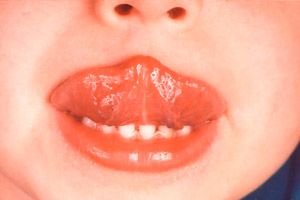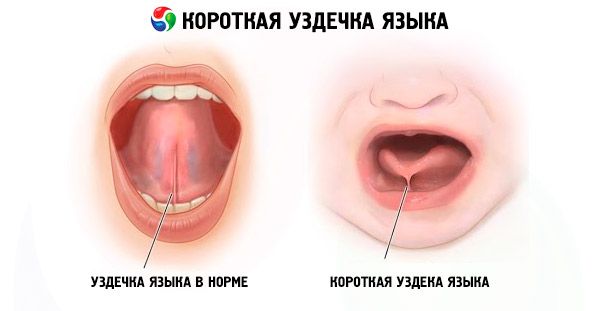
All iLive content is medically reviewed or fact checked to ensure as much factual accuracy as possible.
We have strict sourcing guidelines and only link to reputable media sites, academic research institutions and, whenever possible, medically peer reviewed studies. Note that the numbers in parentheses ([1], [2], etc.) are clickable links to these studies.
If you feel that any of our content is inaccurate, out-of-date, or otherwise questionable, please select it and press Ctrl + Enter.
Short frenulum of the tongue: signs, how to determine, what to do
Medical expert of the article
Last reviewed: 05.07.2025

A congenital condition known as a short frenulum of the tongue, or ankyloglossia, is diagnosed when a small fold of fibrous tissue that connects the surface of the mucous membrane of the lower jaw to the back of the tongue is attached anatomically incorrectly: not in the middle of the lower surface of the tongue, but proximally, that is, closer to its tip.
By limiting the mobility of the tongue, this defect can sometimes cause health problems in children and adults.
Epidemiology
According to some statistics, the prevalence of a shortened lingual frenulum fluctuates between 4.2-10.7% of cases. Moreover, among male children, this defect is observed one and a half times more often than among girls.
A publication in the Journal of Applied Oral Science notes the prevalence of this congenital defect in newborns at 4.4-4.8%. And some studies using other diagnostic criteria indicate the frequency of detection of a shortened sublingual frenulum in children in the range of 25% to 60%.
Experts from the American Board of Family Practice claim that almost 5% of the US population has genetically determined restrictive ankyloglossia. And the results of a study by the University of Cincinnati (USA), published in 2002, showed that about 16% of children who have difficulty breastfeeding have a shortened tongue tie, and it is diagnosed three times more often in boys.
Often people do not consult doctors even when they have problems, but a short frenulum of the tongue in an adult creates many difficulties that arise due to the fact that the tongue cannot move freely in the oral cavity.
Causes short frenulum
The currently known causes of a short frenulum of the tongue are a violation of the ontogenesis (intrauterine formation) of the structures of the oral cavity and facial skeleton during the first weeks of pregnancy.
The tongue begins to develop from the three pharyngeal arches in the fourth week of gestation; a U-shaped groove forms at the front and both sides of the oral portion of the tongue. As the tongue develops, the epithelial cells of the frenulum undergo apoptosis, retracting from the tip of the tongue and increasing tongue mobility – except in the lingual frenulum, where it remains attached. Disturbances at this stage cause ankyloglossia.
This congenital structural anomaly is thought to be due to the phenotypic effect of gene mutations. Shortening of the lingual frenulum is associated with an autosomal karyotype change in the X-linked gene encoding the transcription factor TBX22. Aberrations in the G-protein receptor gene LGR5 or the gene encoding the interferon-regulating transcription factor IRF6 are also thought to be involved in the pathogenesis of this defect. Thus, a short frenulum of the tongue is present in the newborn from the start.
Risk factors
The main risk factors for having a child with ankyloglossia are autosomal dominant inheritance of the altered karyotype in the male line, either in isolation or, in rarer cases, as one of the signs of X-linked cleft palate; Pierre Robin or Van der Woude syndrome; Kindler or Simpson-Golabi-Bemmel syndromes, Beckwith-Wiedemann syndrome or Smith-Lemli-Opitz syndrome.
However, it should be borne in mind that up to 10-15% of congenital structural anomalies are the result of adverse effects of the environment and maternal infections on prenatal development. This means that approximately one in three hundred newborns may have a structural deviation caused by teratogenic factors (including side effects of drugs) that negatively affect the formation and development of a particular organ system of the embryo or fetus. The most critical period of such exposure is from the 8th to the 15th week after fertilization. And an increase in temperature in pregnant women above +38.5-39°C can have a teratogenic effect between the 4th and 14th weeks of pregnancy.
Symptoms short frenulum
In many cases – with minimal deviation of the frenulum length from the anatomical norm – there are no symptoms. This happens with a mild degree of ankyloglossia: when the distance between the frenulum attachment point on the ventral surface of the tongue and its tip is at least 12 mm.
By the way, there are four degrees of ankyloglossia: mild (length of frenulum 12-16 mm), moderate (8-11 mm), severe (3-7 mm) and complete (less than 3 mm).

Symptoms of a short frenulum of the tongue with its moderate and significant shortening in patients of different ages manifest themselves differently. In newborns, the most common first signs are expressed in the violation or complete absence of the ability to breastfeed. Due to the limited mobility of the tongue, the baby cannot grasp the nipple and suck milk normally, which forces the use of a bottle with a nipple. Although with an intensive secretion of breast milk, breastfeeding is possible even with this defect.
Breastfeeding mothers should have an idea of how to identify a short frenulum of the tongue. Signs of a short frenulum of the tongue in an infant may include rapid fatigue during sucking: if the baby often falls asleep at the breast and wakes up hungry and starts crying. For this reason, the child shows increased anxiety at night and does not gain weight well.
In addition, feeding disorders (grasping the nipple not with the tongue, but with the gums) leads to pain and damage to the nipples, blockage of the ducts in the mammary glands and mastitis.
A short frenulum of the tongue in a child of the first three years of life creates problems with the consumption of food that requires chewing. Clear symptoms of ankyloglossia are:
- inability to stick the tongue out beyond the upper gum;
- bending the tongue downwards when sticking it out of the mouth;
- inability to touch the palate with the tongue;
- difficulty moving the tongue from side to side;
- V-shape of the tip of the tongue (resembling a heart pictogram) when it is raised.
After three years, speech problems become noticeable, especially distortions in the articulation of the sounds D-T, Z-S, L, R, N, Ts, Sh. A visit to a specialist is required if more than half of a three-year-old child’s speech is not understood outside the family circle.
With age, the short frenulum of the tongue in an adult can stretch and become longer: it all depends on its thickness and initial size.
Complications and consequences
Shortening of the lingual frenulum limits the range of motion of the tongue, which can cause certain consequences and complications.
As noted, breastfeeding is difficult in breastfed babies, and bottle feeding requires a completely different tongue movement, which often results in the development of a high, narrow, arched palate (which directly affects the nasal cavity).
A short frenulum of the tongue in a child can affect the position of the lower jaw and lead to its prognathism (forward protrusion) with the formation of an open bite. And the constant mechanical pressure of the tongue on the alveolar part of the gums and erupting baby teeth causes crowding of the teeth and an incorrect bite in the child. Children have difficulty chewing food and retaining saliva in the oral cavity, and speech development slows down. Pediatricians note the presence of habitual vomiting and frequent food entering the trachea (with severe coughing and suffocation) due to insufficient mobility of the tongue during eating, as well as swallowing air while eating (aerophagia).
In adults, ankyloglossia with varying degrees of limitation of tongue mobility can cause:
- inability to open the mouth wide;
- difficulty drinking and swallowing pills;
- splashing of saliva during conversation (due to inadequate coordination of swallowing);
- inability to clean teeth with the tongue after eating;
- orthodontic problems (occlusion anomalies and malocclusion, crooked teeth, gap between the lower incisors, prognathism of the lower jaw);
- specific disorders of speech articulation (diction disorders)
- sleep disorders and sleep apnea;
- dysfunction of the temporomandibular joint (pain and limited movement of the jaw).
Diagnostics short frenulum
The main method by which a short lingual frenulum is diagnosed is an examination of the oral cavity to determine the length of the lingual frenulum when the tongue is raised and the length of the free tongue, measuring the distance between the tip of the tongue and the point of attachment of the lingual frenulum to the tongue and attachment to the lower alveolar process.
We remind you that a sublingual cord length of more than 16 mm is considered clinically acceptable.
In addition, the mobility of the tongue (maximum range of movement) and its tip are assessed.
To confirm the diagnosis, children aged two to three years and adults undergo palpation of the muscle on the underside of the tongue – the genioglossus (Musculus genioglossus).
The patient's speech is also assessed: its speed and articulation disorders.
Who to contact?
Treatment short frenulum
With a wait-and-see approach to this structural defect and in the absence of its clearly negative impact on the child's dental system, during growth, the tension of the not very thick shortened frenulum of the tongue (mild and moderate) can weaken over time, and the mobility of the tongue increases. This is facilitated by classes with a speech therapist and special exercises for a short frenulum of the tongue. But you can wait until six years, that is, until the beginning of the replacement of milk teeth with permanent ones.
In other cases, surgical treatment of a short tongue frenulum may be required, which is performed on an outpatient basis by an otolaryngologist-surgeon or a dental surgeon.
Surgical treatment for ankyloglossia includes two types of procedures: frenectomy (frenulectomy) and frenuloplasty.
In a frenectomy, which is considered a relatively common procedure, the frenulum can be cut with surgical scissors or a carbon dioxide laser. The procedure is quick and causes minimal discomfort because the lingual frenulum has few nerve endings and blood vessels (a drop or two of blood may appear). The infant can be breastfed immediately after the procedure.
However, rare complications of frenulum frenectomy are possible - in the form of bleeding, infection, or damage to the tongue or salivary glands. Fusion of the dissected frenulum is also possible.
Frenuloplasty (excision of part of the frenulum) is used in cases of severe and complete ankyloglossia (length of the frenulum is less than 3-7 mm), or the frenulum is too thick for simple dissection. After surgical excision, the wound is usually closed with absorbable sutures. Potential complications of frenuloplasty are similar to frenectomy; there may be formation of scar tissue due to the more extensive nature of the procedure, as well as a reaction to anesthesia.
After frenuloplasty, exercises are also recommended to develop tongue mobility and reduce the possibility of scarring.
Forecast
The prognosis for treating a short frenulum of the tongue in children is favorable in most cases. Dissection of the frenulum in a newborn improves its natural feeding and ensures normal physiological development.
 [ 26 ]
[ 26 ]

